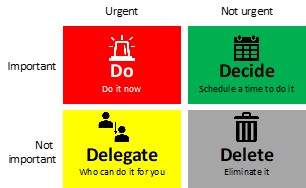Sensemaking in the Agile Forest
SERIES ARTICLE
By Henny Portman
The Netherlands
Introduction
How to prioritize work in an agile team? The time is thankfully past when the person with the loudest voice has the upper hand. However, the amount of work to be done is often more than a team can handle in a time period. That means making choices and setting priorities. In this blog, a number of prioritization techniques are reviewed, such as the Eisenhower matrix, MoSCoW (KYIV), Kano and WSJF.
Eisenhower matrix
A famous quote from General Dwight D. Eisenhower is “Plans are nothing, planning is everything.” During planning you discuss what you want to achieve as a minimum. In order to be able to set priorities quickly and decisively, he devised a handy and simple tool. In the Eisenhower matrix, two questions are compared.
- Is it important?
- Is it urgent?
Based on these two questions you can then decide whether to take it up immediately, carry it out later, delegate it or not carry it out. Problem with this is that if there are too many important and urgent things, you still don’t know what to pick up first. So how then to prioritize in an agile team?

MoSCoW
A common method of prioritizing requirements or backlog items is the MoSCoW method. It is an abbreviation, whose letters stand for:
- M Must haves: non-negotiable. Without it, the project has no right to exist.
- S Should haves: important but not indispensable. Without this, the end product may still provide value. A workaround may be needed.
- C Could haves: desirable, but not as important as the should haves. Are only executed if there is sufficient time and budget.
- W Won’t have: not needed at this time. Has no business value right now (maybe in of the next sprints).
With the MoSCoW method, the same problem applies as with the Eisenhower matrix. How do you deal with too many must haves? AgilePM uses the following rule of thumb: when planning, a maximum of 60% must haves, 20% should haves and 20% could haves is used to ensure that at least all must haves are realized. In case of setbacks, the won’t haves are sacrificed first, followed by the could haves.
More…
To read entire article, click here
Editor’s note: This is the second article in a series by Henny Portman, one of the world’s leading authorities on “agile”. Based in The Netherlands, Henny coined the term “agile forest” in 2019 to describe the many agile frameworks that have emerged over the last 20 years. This series is intended to help readers better understand the agile concept, navigate through the ‘underbrush’ and more successfully apply whichever framework is selected for their projects.
How to cite this article: Portman, H. (2022). Prioritizing in an agile team, Sensemaking in the Agile Forest, series article, PM World Journal, Vol. XI, Issue IX, September. Available online at https://pmworldlibrary.net/wp-content/uploads/2022/09/pmwj121-Sep2022-Portman-Prioritizing-in-an-agile-team-agile-forest-series-article.pdf
About the Author

Henny Portman
The Netherlands
![]()
Henny Portman, owner of Portman PM[O] Consultancy and was partner of HWP Consulting, has 40 years of experience in the project management domain. He was the project management office (PMO) thought leader within NN Group and responsible for the introduction and application of the PMO methodologies (portfolio, program, and project management) across Europe and Asia. He trains, coaches, and directs (senior) programme, project and portfolio managers and project sponsors at all levels, and has built several professional (PM(O)) communities.
Henny Portman is accredited in a variety of qualifications, including P3O, PRINCE2, MSP, MoP, PRINCE2 Agile, AgilePM, AgilePgM and AgileSHIFT trainer and an SPC4 SAFe consultant and trainer. He is a P3M3 trainer and assessor and PMO Value Ring Certified Consultant (PMO Global Alliance). On behalf of IPMA, he assesses mega and large projects for the IPMA Project Excellence Award. In addition to this, he is an international speaker, author of many articles and books in the PM(O) field, and an active blogger. More at hennyportman.wordpress.com
Henny can be contacted at henny.portman@gmail.com
To view other works by Henny Portman, visit his author showcase in the PM World Library at https://pmworldlibrary.net/authors/henny-portman/









